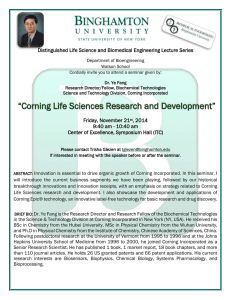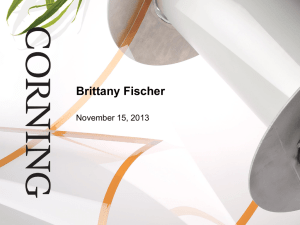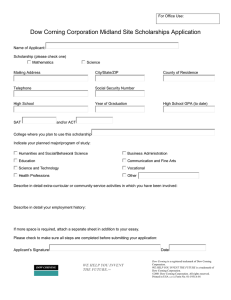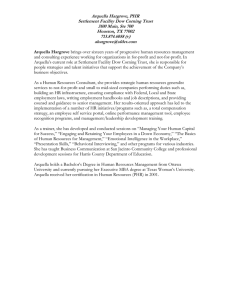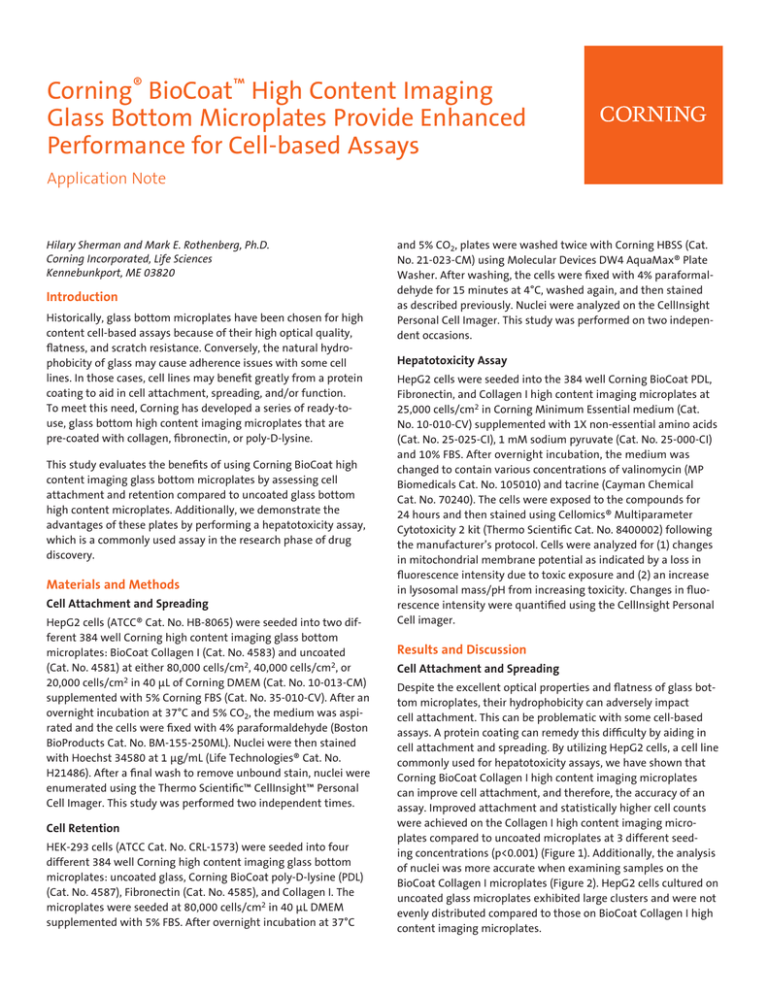
Corning® BioCoat™ High Content Imaging
Glass Bottom Microplates Provide Enhanced
Performance for Cell-based Assays
Application Note
Hilary Sherman and Mark E. Rothenberg, Ph.D.
Corning Incorporated, Life Sciences
Kennebunkport, ME 03820
Introduction
Historically, glass bottom microplates have been chosen for high
content cell-based assays because of their high optical quality,
flatness, and scratch resistance. Conversely, the natural hydrophobicity of glass may cause adherence issues with some cell
lines. In those cases, cell lines may benefit greatly from a protein
coating to aid in cell attachment, spreading, and/or function.
To meet this need, Corning has developed a series of ready-touse, glass bottom high content imaging microplates that are
­pre-coated with collagen, fibronectin, or poly-D-lysine.
This study evaluates the benefits of using Corning BioCoat high
content imaging glass bottom microplates by assessing cell
attachment and retention compared to uncoated glass bottom
high content microplates. Additionally, we demonstrate the
advantages of these plates by performing a hepatotoxicity assay,
which is a commonly used assay in the research phase of drug
discovery.
Materials and Methods
Cell Attachment and Spreading
HepG2 cells (ATCC® Cat. No. HB-8065) were seeded into two different 384 well Corning high content imaging glass bottom
microplates: BioCoat Collagen I (Cat. No. 4583) and uncoated
(Cat. No. 4581) at either 80,000 cells/cm2, 40,000 cells/cm2, or
20,000 cells/cm2 in 40 µL of Corning DMEM (Cat. No. 10-013-CM)
supplemented with 5% Corning FBS (Cat. No. 35-010-CV). After an
overnight incubation at 37°C and 5% CO2, the medium was aspirated and the cells were fixed with 4% paraformaldehyde (Boston
BioProducts Cat. No. BM-155-250ML). Nuclei were then stained
with Hoechst 34580 at 1 µg/mL (Life Technologies® Cat. No.
H21486). After a final wash to remove unbound stain, nuclei were
enumerated using the Thermo Scientific™ CellInsight™ Personal
Cell Imager. This study was performed two independent times.
Cell Retention
HEK-293 cells (ATCC Cat. No. CRL-1573) were seeded into four
different 384 well Corning high content imaging glass bottom
microplates: uncoated glass, Corning BioCoat poly-D-lysine (PDL)
(Cat. No. 4587), Fibronectin (Cat. No. 4585), and Collagen I. The
microplates were seeded at 80,000 cells/cm2 in 40 µL DMEM
supplemented with 5% FBS. After overnight incubation at 37°C
and 5% CO2, plates were washed twice with Corning HBSS (Cat.
No. 21-023-CM) using Molecular Devices DW4 AquaMax® Plate
Washer. After washing, the cells were fixed with 4% paraformaldehyde for 15 minutes at 4°C, washed again, and then stained
as described previously. Nuclei were analyzed on the CellInsight
Personal Cell Imager. This study was performed on two independent occasions.
Hepatotoxicity Assay
HepG2 cells were seeded into the 384 well Corning BioCoat PDL,
Fibronectin, and Collagen I high content imaging microplates at
25,000 cells/cm2 in Corning Minimum Essential medium (Cat.
No. 10-010-CV) supplemented with 1X non-essential amino acids
(Cat. No. 25-025-CI), 1 mM sodium pyruvate (Cat. No. 25-000-CI)
and 10% FBS. After overnight incubation, the medium was
changed to contain various concentrations of valinomycin (MP
Biomedicals Cat. No. 105010) and tacrine (Cayman Chemical
Cat. No. 70240). The cells were exposed to the compounds for
24 hours and then stained using Cellomics® Multiparameter
Cytotoxicity 2 kit (Thermo Scientific Cat. No. 8400002) following
the manufacturer’s protocol. Cells were analyzed for (1) changes
in mitochondrial membrane potential as indicated by a loss in
­fluorescence intensity due to toxic exposure and (2) an increase
in lysosomal mass/pH from increasing toxicity. Changes in fluorescence intensity were quantified using the CellInsight Personal
Cell imager.
Results and Discussion
Cell Attachment and Spreading
Despite the excellent optical properties and flatness of glass bottom microplates, their hydrophobicity can adversely impact
cell attachment. This can be problematic with some cell-based
assays. A protein coating can remedy this difficulty by aiding in
cell attachment and spreading. By utilizing HepG2 cells, a cell line
commonly used for hepatotoxicity assays, we have shown that
Corning BioCoat Collagen I high content imaging microplates
can improve cell attachment, and therefore, the accuracy of an
assay. Improved attachment and statistically higher cell counts
were achieved on the Collagen I high content imaging microplates compared to uncoated microplates at 3 different seeding concentrations (p<0.001) (Figure 1). Additionally, the analysis
of nuclei was more accurate when examining samples on the
BioCoat Collagen I microplates (Figure 2). HepG2 cells cultured on
uncoated glass microplates exhibited large clusters and were not
evenly distributed compared to those on BioCoat Collagen I high
content imaging microplates.
Cell Retention
Hepatotoxicity Assay
Many cell-based assays require multiple wash steps for high
­content imaging applications (e.g., hepatotoxicity assays). Cell
loss during liquid handling steps can be highly problematic resulting in instrument focusing errors, increased scan times, reduced
cells for analysis, and higher coefficients of variance. Utilization
of Corning® BioCoat™ Collagen I and Fibronectin high content
imaging microplates, resulted in statistically higher HEK-293 cell
retention after washing when compared to traditional uncoated
glass high content microplates (p<0.001) (Figure 3). In addition
to higher cell retention, the coefficient of variance was decreased
when cells were cultured on BioCoat Fibronectin and BioCoat PDL
high ­content imaging microplates (Figure 4).
An important component in the research stage of the drug discovery process is the analysis of potential hepatotoxicity. The
early identification of hepatotoxic compounds helps to reduce
the rate of drug candidate failures.
Figure 1. HepG2 cells exhibit improved attachment on Corning BioCoat
Collagen I high content imaging glass bottom microplates, as compared
to uncoated glass microplates at all three seeding concentrations. Data
is shown with standard errors. One-way ANOVA with Newman-Keuls post
test ***p<0.001. n = 128 from 2 independent studies. 16 fields per well
­analyzed.
In this assay, HepG2 cells were cultured on Corning BioCoat high
content imaging microplates and analyzed for changes in mitochondrial potential (mmp) and lysosomal mass, which are two
early indicators of hepatotoxicity. Valinomycin, a potent anti­
biotic, was added to the cells to depolarize the mitochondrial
membrane, resulting in cellular toxicity1-2. As depicted in
Figure 5, cells exposed to valinomycin demonstrate a dose-­
Uncoated Collagen I Uncoated Collagen I Uncoated Collagen I
80k
80k
40k
40k
20k
20k
Figure 2. Representative photomicrographs of HepG2 cells on uncoated
glass microplates (left) and Corning BioCoat Collagen I (right) high content imaging glass bottom microplates at 80,000 cells/cm2. HepG2 cells
on Collagen I exhibit more even distribution and less clumping compared
to uncoated glass microplates. Improved cell distribution on Collagen I
enables a more accurate analysis of cell nuclei using high content imaging
(note the distribution of nuclei outlined in blue).
Figure 3. HEK-293 cells exhibit improved retention on Corning BioCoat
Fibronectin and Collagen I high content imaging glass bottom microplates
compared to uncoated glass microplates. Data shown with standard
errors. One-way ANOVA with Newman-Keuls post-test ***p<0.001.
n = 768 from 2 independent studies. 16 fields per well analyzed.
Figure 4. HEK-293 cells cultured on Corning BioCoat PDL and Fibronectin
high content imaging glass bottom microplates exhibit lower ­coefficient
of variance (CV) values compared to uncoated glass microplates.
2
dependent decrease in mmp staining as indicated by a decrease
in the intensity of the mitochondrial stain. This decrease in mmp
staining as the valinomycin concentration increases is an indication of cytotoxicity. Representative photomicrographs of mmp
stained HepG2 cells at 0 µM (left image) and 12.5 µM (right image)
concentrations of valinomycin are shown in Figure 6. A second
hepatotoxic compound, tacrine, was used in the treatment of
Alzheimer’s disease prior to discontinuation in the U.S.3 Tacrine
was added to HepG2 cells to induce changes in lysosomal mass,
which is an early indicator of cell toxicity4. As depicted in Figure 7,
cells exposed to tacrine (100 µM) demonstrated an increase in
the number of lysosomes, indicating hepatotoxicity. High content
analysis confirmed a dose-dependent increase in lysosomal mass
(Figure 8) with increasing concentrations of tacrine.
Conclusions
w Corning® BioCoat™ high content imaging glass bottom micro-
plates support improved cell attachment and retention when
compared to uncoated glass microplates.
w Cells cultured on Corning BioCoat microplates exhibit improved
spreading and even distribution resulting in improved data
quality.
w Corning BioCoat high content imaging glass bottom microplates
are a useful tool for multistep cell-based assays such as a multiparameter toxicity assay.
Figure 6. Representative photomicrographs of HepG2 cells exposed to
0 μM valino­mycin (left) and 12.5 μM valinomycin (right). Green staining
represents mitochondrial membrane potential and blue staining indicates
nuclei. Images taken using 20X objective.
Figure 5. HepG2 cells exhibit reduced mitochondrial membrane potential
when exposed to increasing concentrations of valinomycin. n = 12 from
2 independent studies. 16 fields per well analyzed.
Figure 7. Representative photomicrographs of HepG2 cells exposed to
0 μM tacrine (left) and 100 μM tacrine (right). Cells were stained with
a marker to identify lysosomes, red, and the nuclei were stained with
Hoechst, blue. Images taken using 20X objective.
Figure 8. HepG2 cells exhibit increased lysosomal mass when exposed to
increasing concentrations of tacrine. n = 12 from 2 independent studies.
16 fields per well analyzed.
3
References
1.Tong V, Teng XW, Chang TKH, and Abbott FS. Valproic Acid II: Effects on Oxidative Stress, Mitochondrial Membrane
Potential, and Cytotoxicity in Glutathione-Depleted Rat Hepatocytes. Tox Sci. 86(2):436-443 (2005).
2.Inai Y, Yabuki M, Kanno T, Akiyama J, Yasuda T, Utsumi K. Valinomycin induces apoptosis of ascites hepatoma cells
(AH-130) in relation to mitochondrial membrane potential. Cell Struct Funct. 22(5):555-63 (1997).
3.Galisteo M et al., Hepatotoxicity of Tacrine: Occurrence of Membrane Fluidity Alterations without Involvement of
Lipid Peroxidation. ASPET. 294(1):160-167 (2000).
4.Monteith DK, Theiss JC, Haskins JR, de la Iglesia FA. Functional and subcellular organelle changes in isolated rat and
human hepatocytes induced by tetrahydroaminoacridine. Arch Toxicol. 72(3):147-156 (1998).
Warranty/Disclaimer: Unless otherwise specified, all products are for research use only. Not intended for use
in diagnostic or therapeutic procedures. Not for use in humans. Corning Life Sciences makes no claims regarding the performance of these products for clinical or diagnostic applications.
Beginning-to-end
Solutions for
Cell Culture
At Corning, cells are in our culture. In our continuous efforts to improve efficiencies and develop new
tools and technologies for life science researchers, we have scientists working in Corning R&D labs across
the globe, doing what you do every day. From seeding starter cultures to expanding cells for assays, our
technical experts understand your challenges and your increased need for more reliable cells and cellular
material.
It is this expertise, plus a 160-year history of Corning innovation and manufactur­ing ­excellence, that
puts us in a unique position to offer a beginning-to-end portfolio of high-quality, reliable cell culture
consumables.
For additional product or technical information, please call 800.492.1110 or
visit www.corning.com/lifesciences. Customers outside the United States, call
+1.978.442.2200 or contact your local Corning sales office listed below.
Corning Incorporated
Life Sciences
836 North St.
Building 300, Suite 3401
Tewksbury, MA 01876
t 800.492.1110
t 978.442.2200
f 978.442.2476
www.corning.com/lifesciences
Worldwide
Support Offices
ASIA/PACIFIC
Australia/New Zealand
t 0402-794-347
China
t 86 21 2215 2888
f 86 21 6215 2988
India
t 91 124 4604000
f 91 124 4604099
Japan
t 81 3-3586 1996
f 81 3-3586 1291
Korea
t 82 2-796-9500
f 82 2-796-9300
Singapore
t 65 6733-6511
f 65 6861-2913
Taiwan
t 886 2-2716-0338
f 886 2-2516-7500
For a listing of trademarks, visit us at www.corning.com/lifesciences/trademarks.
All other trademarks in this document are the property of their respective owners.
EUROPE
France
t 0800 916 882
f 0800 918 636
Germany
t 0800 101 1153
f 0800 101 2427
The Netherlands
t 31 20 655 79 28
f 31 20 659 76 73
United Kingdom
t 0800 376 8660
f 0800 279 1117
All Other European
Countries
t 31 (0) 20 659 60 51
f 31 (0) 20 659 76 73
LATIN AMERICA
Brasil
t (55-11) 3089-7419
f (55-11) 3167-0700
Mexico
t (52-81) 8158-8400
f (52-81) 8313-8589
© 2014 Corning Incorporated. All rights reserved. Printed in U.S.A. 10/14 CLS-AN-244 REV1
www.corning.com/lifesciences/solutions

